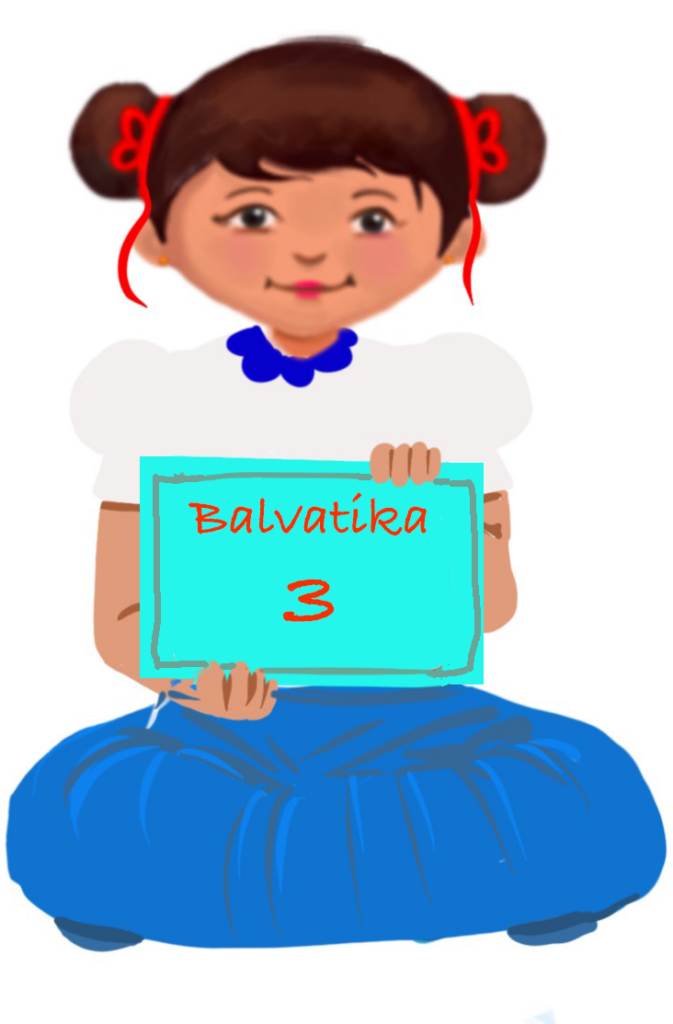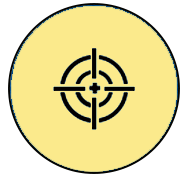
Comparing Objects
Week 3 – Heavy or Light
Learning Outcome
Compares two objects in terms of their weight as heavy and light and uses vocabulary like heavier than, lighter than.
 Objective
Objective
Children will learn to use vocabulary like heavy and light in the context of different objects around them.
 Prerequisites
Prerequisites
● Children should be able to identify different items around them.
● The teacher can have a simple check for the child’s ability to distinguish items by showing them different objects available in the classroom and asking them to identify the objects based on some criteria or do a simple sorting.
Introduction – Story
Mickey and Ellie
The teacher can narrate the following story along with a video depicting the story.
In the vibrant animal kingdom, Ellie the elephant and Mickey the mouse were inseparable friends. One sunny day, they decided to have a picnic by the sparkling pond. Ellie packed a large basket of fruits, while Mikey carried a small basket with some cheese.
As they settled down, Ellie’s immense weight caused the ground to gently tremble. Mickey inquired, “Ellie, why does the ground shake when you sit?” Ellie, with a warm smile, answered, “Well, Mickey, it’s because I’m a very heavy elephant. Heavy objects like me make the ground shake a little.”
Mickey, the ever-curious mouse, decided to experiment. He placed a delicate feather found on the ground and a sturdy rock piece side by side. When he blew on the feather, it flew around, but the rock pieces remained steadfast. Mickey chuckled, saying, “Ellie, the feather is light, and the rock piece is heavy, just like us!” Hah! Hah!
Now let us watch the video: Mickey and Ellie.
Video: Mickey and Ellie
ISL Video: Mickey and Ellie
After watching the video/ story narration, the teacher can ask the students:
Have you ever wondered why some objects are difficult to pick up and some are easy to pick up? Let us find this out. We will learn how to spot heavy things around us and find out things that are light, like a balloon or a feather.
Resources required:
- Eraser/s
- Book/s
- Any other object/s of teacher’s choice to compare
- A weighing balance
Heavy or Light: Feel and tell:
- The teacher can start the class by using familiar objects from the environment. Let the children feel the objects, and the teacher should encourage them to describe how each object feels in their hands.
- The teacher can first ask any student to pick up an eraser and a book and ask which was more difficult to pick up. Then she can explain that it was difficult to pick up a book because it was heavy and eraser was easy to pick up since it was light.
- Similarly, she can repeat the exercise with different objects and make comparisons using a weighing balance.
- Place the balance on a flat surface.
- Take one object and place it on one side of the balance.
- Ask the child what they think will happen. Then take another object and place it on the opposite side of the balance.
- Ask the child to observe and describe what happens.
- Discuss with the child which side of the balance went down, and explain that the side that goes down has the heavier object.
- The side that goes up has the lighter object.
- Continue this with several different objects and make the children predict which object they think is heavier before placing them on the balance.
Refer to ‘Receptive and Expressive language skills’ Adaptations and Strategies given in the Main page of ‘Comparing Objects’ if there are any neuro-diverse children in the class.
Activity 1: Lift and Compare
Objective:
To identify and compare objects as heavier or lighter.
Importance of the activity for children:
Helps in developing:
- Gross motor skills (balancing the weighing machine, lifting the objects, holding the objects)
- Fine motor skills (picking, holding, hand-eye coordination)
- Cognitive skills (guessing the weight, verifying, reasoning, critical thinking)
- Sensory perception skills (differentiating between heavy and light)
- Social skills (cooperation, watching while others measure)
- Emotional skills (sense of achievement on completion builds self-esteem)
- Mathematical skills (comparing weights and understanding relative weight and mass)
- Vocabulary skills (heavier, lighter, weighing scale)
Resources required:
- Soft toys
- Books
- Beads
- Buttons
- Toys
- Fruits
- Feather
- Any other object available according to the teacher’s discretion
- A weighing scale
- A basket
Setting for the activity:
The activity can be done indoors or outdoors, depending on the availability of space.
Type of activity: Pair activity
Preparation of activity:
- The teacher should get the objects to be compared, ready in front of the children.
- A weighing scale to be used after the children guess which is heavier and which is lighter.
- The results can be written on the board.
Role of the teacher: Demonstrator and facilitator.
Procedure:
- The objects are kept in a basket, in front of the students.
- Two students pick an object simultaneously from the basket.
- They compare both the objects by holding them and deciding which object is heavier and which is lighter.
- Once the children express their estimates about which is heavier and which is lighter, the teacher will make use of a weighing scale to compare the weight of the objects.
Observation:
The children observe the weighing scale and find out if their guess is right. They learn to compare two objects in the context of their weight as heavy and light. The teacher can guide them if needed while identifying which object is heavier based on the tipping of the balance.
Conclusion:
● The children will learn to use comparative words.
● They also learn that an object can be heavier or lighter in comparison to one another.
Refer to ‘Fine motor skills’ Adaptations and Strategies given in the Main page of ‘Comparing Objects’ if there are any neuro-diverse children in the class.
Video: Lift and compare
ISL Video: Lift and compare
Activity 2: Create, Weigh and Observe!
Objective:
● To make your own weighing balance and weigh the objects.
● Use comparative words to communicate.
Importance of the activity for children:
Helps in developing:
- Gross motor skills (hand movements in making the balance)
- Fine motor skills (picking various objects, holding, hand-eye coordination)
- Cognitive skills (exploring, reasoning, critical thinking)
- Sensory perception skills (differentiating between heavy and light)
- Social skills (cooperation, watching while others measure)
- Emotional skills (sense of achievement on completion builds self-esteem)
- Mathematical skills (comparing weights and understanding relative weight and mass)
- Vocabulary skills (heavier, lighter, weighing scale)
Resources required:
- Stone pieces
- Spoon
- Pen
- Balloon
- Leaf
- Feather
- Flower
- Hanger
- Anything in the surrounding that could be used for weighing.
- Thread/wool to tie on both sides of the hanger.
LTM Video: Make a weighing scale
Setting for the activity:
The activity can be done indoors or outdoors, depending on the availability of space.
Type of activity:
Group activity (Group of 4 to 6 children)
Preparation of activity:
● The teacher keeps all the materials ready.
● If there are 4 groups in the class, the teacher can keep the plastic cups with holes and thread tied to them ready for the children to tie them on the hangers.
Role of the teacher: Demonstrator and facilitator
Procedure:
- The teacher demonstrates how to make a weighing balance.
- The children follow the steps shown in the DIY video and make a weighing balance.
- Then children pick up two objects, place on the two cup pans to weigh and write their observations.
Suggested variation in the activity:
- The children can use recycled materials (bottle caps, plastic bottles, etc.) to create the balance and weighing pans.
- The children can predict which object is heavier or lighter before weighing.
- The children can first group similar types of objects (e.g., natural vs. man-made) and compare their weights.
Observation:
The children will use words such as lighter and heavier to compare the objects. The teacher can guide them if needed while identifying which object is heavier based on the tipping of the balance.
Conclusion:
The children will learn to use comparative words.
Refer to ‘Visuospatial skills’ Adaptations and Strategies given in the Main page of ‘Comparing Objects’ if there are any neuro-diverse children in the class.
Video: Create, weigh and observe!
ISL Video: Create, weigh and observe!
Assessment
The teacher can give the assessment worksheet at the end of the lesson.
Resources required: Worksheet
Worksheet: Practice – Heavy or light
Worksheet: Practice – Heavy or light (Enlarged)
Worksheet: Assessment – Heavy or light
Worksheet: Assessment – Heavy or light (Enlarged)
Home Activity: Let’s Fly and Soar High
Objective:
To practice comparative words.
Resources required:
- Paper airplanes
- Feather
- Chalk piece
- Adhesive tape
Setting for the activity:
The activity can be done outdoors in safe places, under parental supervision.
Type of activity: Individual activity
Procedure:
- Children make a paper plane.
- They first attach the feather to the paper airplane with adhesive and fly it.
- Repeat with the chalk piece.
- The teacher can ask the children to record their observations during this activity at home and discuss them in the class the following day.
Observation:
The children use comparative words and explain their experiment.
Conclusion:
The children will learn to use comparative words.
Note to the teacher: The teacher can show the DIY video in the class and the video link can be shared with parents.
LTM Video: DIY – Paper plane
Cross-Curricular Connection:
Art and Craft
- The teacher can teach the children how to make paper boats and paper planes in the respective activities. The children can choose to color them at a later time and display their craft.
- In language class, sentence construction using heavy and less can be introduced. Example, Table is heavy. Book is light. Pencil is lighter than book. Children can be asked to construct sentences using the terms heavy/heavier and light/lighter
Check list for teacher:
| Activity | Yes | No | Sometimes |
| Children can: | |||
| Identify and compare heavy and light objects | |||
| Guess which object is heavy and which object is light | |||
| Relate the terms heavy and light in real life situations | |||
| Focus on the activity | |||
| Complete the activity in the given time | |||
| Do the activity independently | |||
| Express verbally and through actions, expressions or gestures |
Teacher Resource Document
| Source and Attribution of images: All images used in the above Assets and Aids are originally created. |
| This digital material has been developed by the Sri Sathya Sai Vidya Vahini Inclusive Education Project, a unit of Sri Sathya Sai Central Trust, Prasanthi Nilayam, as a collaborative offering in the service of our nation. |